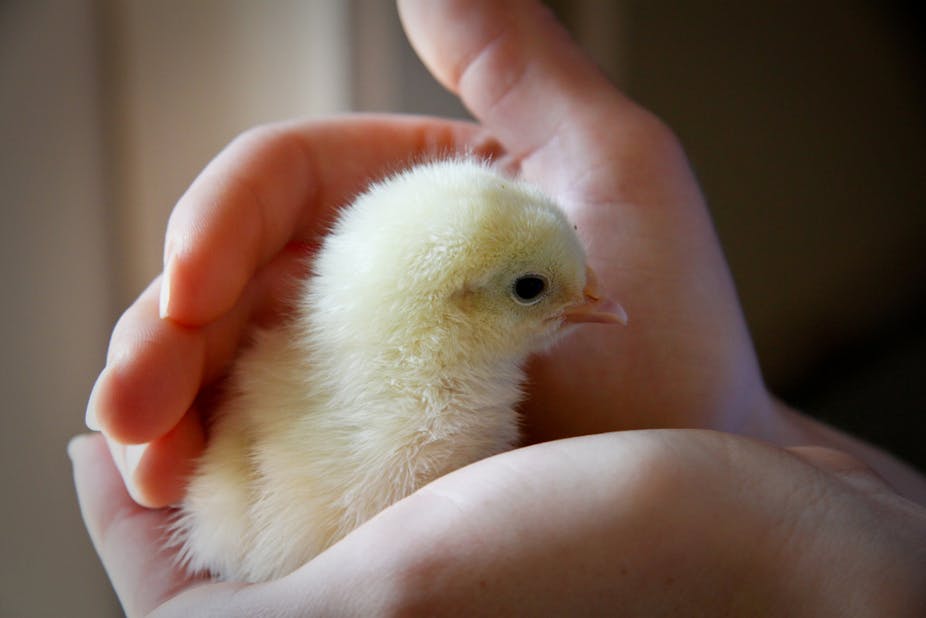The humble pigeon has been in the scientific spotlight lately since the discovery that the much-maligned species is far smarter than previously thought. A study by psychologist Damian Scarf and colleagues – discussed recently on The Conversation – showed pigeons possess numerical abilities comparable to those found in primates.
But while pigeons surprised many with their “numerical competence”, there’s arguably an even better performer among our feathered friends: the domestic chick (Gallus gallus).
More on chicks in a moment, of course, but before we get there it’s worth asking: why all the buzz about the numerical ability of animals?
This area has attracted particular interest in the past few decades because numerical competency has, traditionally, been linked with language. Put simply, it was long believed that numerical competency evolved in humans at the same time as language.
We now know this to be untrue. To explain why, we need to understand the different levels of numerical ability.
The most basic form is the ability to make judgments of size between different sets of items (“there are three worms in this group and four in that group”). This ability serves animals well in food searching and allows such animals to choose collections of food with more items. This ability is demonstrated by very young domestic chicks when they choose to approach objects on which they have been imprinted.
Italian psychologists Rosa Rugani, Lucia Regolin and (one of your current authors) Giorgio Vallortigara showed chicks prefer to join groups of more objects versus a single object or a smaller set of objects. Since these “objects” would normally be social companions, the preference for larger groups probably reflects flocking behaviour.
The results of these tests, made with many adequate controls, were quite similar to those obtained with human infants. Human infants, it would seem, are also attracted to larger groups.

The next numerical ability is recognition of “serial relations” (the order of numbers), as seen in monkeys and in the pigeons studied by Scarf and colleagues. Simply put, monkeys and pigeons can be trained to discriminate between the numbers one to nine in ascending order and can do so with relative ease or difficulty according to Weber’s Law.
Weber’s Law states that the difficulty of any numerical discrimination depends on the ratio of the two numbers. For instance, animals trained to discriminate between the numbers three and four can also discriminate with ease between six and eight (being two times three and four, respectively) but find discrimination between three and five more difficult.
As discussed by Scarf and colleagues in their paper, monkeys and pigeons demonstrate an ability to learn to choose a target on the basis of its ordinal position (for example, third, eighth, ninth) in an array.
Pigeons (and monkeys) are not special in having this ability. Rats and bees have the ability to recognise ordinal position and, as seen in the experiments by Rugani, myself (Giorgio) and colleagues, young chicks possess this ability too.
The most complex numerical ability is to manipulate numbers by performing simple arithmetic. We know rhesus monkeys can do this and we know that five-day-old chicks can too.
My colleagues and I (Giorgio) imprinted chicks on a small ball and then allowed them to watch as the imprinting ball moved behind one of two screens in a large arena.
After being released into the testing arena, the chicks approach the screen behind which they had seen the ball disappear. Since chicks prefer to approach a group of imprinting objects, rather than one or a group of fewer objects, this test can be used to determine whether they can add and subtract.
Several balls can be made to disappear behind one screen and then re-appear to move behind the other screen as the chick watches. Once released into the arena, the chick chooses the screen behind which more balls have disappeared in the final step of the test. In other words, the chick has been able to subtract balls that move from one screen to the other and add to those it has already seen disappear behind a screen (see video below).
This ability is more complex than that demonstrated in the pigeon.
The experiments used to show this in chicks do not require excessive training, while the pigeons tested by Scarf and colleagues did. Excessive training can cause problems of its own but, most importantly, the numerical abilities shown by young chicks suggest animals possess core systems of knowledge about numerosity, just as they also do about geometry and the physical properties of objects.
So what does all of this mean?
Well, it shows that numerical competence evolved early and that, in the evolution of animals (including humans), numerical competence appeared long before language did. Of course it also means there’s far more to chicks than just cute balls of fluff.
Further reading:

